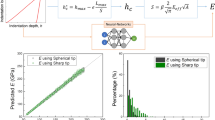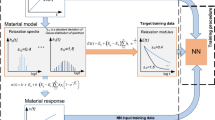Abstract
Instrumented indentation is a versatile method of extracting hyper-elastic material parameters, particularly useful for applications where stress-strain data are difficult to be in-situ measured. Because the analytical force-displacement relation is still unavailable for the indentation of hyper-elastic materials, identifying hyper-elastic parameters often requires an iterative optimization strategy that fits finite element simulations with experimental data. However, the optimization strategy is burdened by heavy computation and its prediction accuracy is greatly influenced by the choice of optimization algorithm. To address these challenges in this study, a bidirectional long short-term memory (BLSTM) neural network is presented that directly predicts hyper-elastic material parameters from indentation load-displacement data, focusing on Mooney-Rivlin hyper-elasticity as an example. To improve the predication accuracy, the condition numbers for the inverse identification of the hyper-elastic parameters are investigated. And, a normalization procedure is proposed to treat the input data, which can guarantee the BLSTM network is well-conditioned. During evaluation, the trained BLSTM network significantly outperforms the iterative optimization strategy using a genetic algorithm. Furthermore, the effect of the normalization procedure is demonstrated.
Similar content being viewed by others
References
K. Chaimoon and P. Chindaprasirt, An anisotropic hyperelastic model with an application to soft tissues, European Journal of Mechanics - A/Solids, 78 (2019) 103845.
S. K. Melly, L. Liu, Y. Liu and J. Leng, A review on material models for isotropic hyperelasticity, International Journal of Mechanical System Dynamics, 1 (1) (2021) 71–88.
G. Marckmann and E. Verron, Comparison of hyperelastic models for rubber-like materials, Rubber Chemistry and Technology, 79 (2006) 835–858.
E. Cosola, K. Genovese, L. Lamberti and C. Pappalettere, A general framework for identification of hyper-elastic membranes with moiré techniques and multi-point simulated annealing, International Journal of Solids and Structures, 45 (24) (2008) 6074–6099.
K. K. Dwivedi, P. Lakhani, S. Kumar and N. Kumar, A hyperelastic model to capture the mechanical behaviour and histological aspects of the soft tissues, Journal of the Mechanical Behavior of Biomedical Materials, 126 (2022) 105013.
R. Rynkevic, J. Ferreira, P. Martins, M. Parente and A. A. Fernandes, Linking hyperelastic theoretical models and experimental data of vaginal tissue through histological data, Journal of Biomechanics, 82 (2019) 271–279.
A. Kossa and S. Berezvai, Novel strategy for the hyperelastic parameter fitting procedure of polymer foam materials, Polymer Testing, 53 (2016) 149–155.
R. W. Ogden, G. Saccomandi and I. Sgura, Fitting hyperelastic models to experimental data, Computational Mechanics, 34 (6) (2004) 484–502.
J. Fernndez, J. Lpez-Campos, A. Segade and J. Viln, A genetic algorithm for the characterization of hyperelastic materials, Applied Mathematics and Computation, 329 (2018) 239–250.
K. Kenja, S. Madireddy and K. Vemaganti, Calibration of hyperelastic constitutive models: the role of boundary conditions, search algorithms, and experimental variability, Biomechanics and Modeling in Mechanobiology, 19 (5) (2020) 1935–1952.
L. Cai, L. Ren, Y. Wang, W. **e, G. Zhu and H. Gao, Surrogate models based on machine learning methods for parameter estimation of left ventricular myocardium, Royal Society Open Science, 8 (1) (2021) 201121.
S. S. Sajjadinia, B. Carpentieri, D. Shriram and G. A. Holzapfel, Multi-fidelity surrogate modeling through hybrid machine learning for biomechanical and finite element analysis of soft tissues, Computers in Biology and Medicine, 148 (2022) 105699.
L. Liang, M. Liu, C. Martin and W. Sun, A deep learning approach to estimate stress distribution: a fast and accurate surrogate of finite-element analysis, Journal of The Royal Society Interface, 15 (138) (2018) 20170844.
J. Hou, X. Lu, K. Zhang, Y. **g, Z. Zhang, J. You and Q. Li, Parameters identification of rubber-like hyperelastic material based on general regression neural network, Materials, 15 (11) (2022) 3776.
E. Tyulyukovskiy and N. Huber, Identification of viscoplastic material parameters from spherical indentation data: part I. neural networks, Journal of Materials Research, 21 (3) (2006) 664–676.
C. M. Hamel, K. N. Long and S. L. B. Kramer, Calibrating constitutive models with full-field data via physics informed neural networks, Strain, 59 (2) (2022) e12431.
S. Kakaletsis, E. Lejeune and M. K. Rausch, Can machine learning accelerate soft material parameter identification from complex mechanical test data?, Biomechanics and Modeling in Mechanobiology, 22 (2023) 57–70.
B. Pierrat, D. MacManus, J. Murphy and M. Gilchrist, Indentation of heterogeneous soft tissue: Local constitutive parameter map** using an inverse method and an automated rig, Journal of the Mechanical Behavior of Biomedical Materials, 78 (2018) 515–528.
V. L. Saux, Y. Marco, G. Bles, S. Calloch, S. Moyne, S. Plessis and P. Charrier, Identification of constitutive model for rubber elasticity from micro-indentation tests on natural rubber and validation by macroscopic tests, Mechanics of Materials, 43 (12) (2011) 775–786.
Z. Chen, T. Scheffer, H. Seibert and S. Diebels, Macroindentation of a soft polymer: Identification of hyperelasticity and validation by uni/biaxial tensile tests, Mechanics of Materials, 64 (2013) 111–127.
M. Drass, G. Schwind, J. Schneider and S. Kolling, Adhesive connections in glass structures — part II: material parameter identification on thin structural silicone, Glass Structures and Engineering, 3 (1) (2018) 55–74.
Z. Oddes and D. Solav, Identifiability of soft tissue constitutive parameters from in-vivo macro-indentation, Journal of the Mechanical Behavior of Biomedical Materials, 140 (2023) 105708.
S. Hartmann and R. R. Gilbert, Identifiability of material parameters in solid mechanics, Archive of Applied Mechanics, 88 (1–2) (2017) 3–26.
M. G. Zhang, Y. P. Cao, G. Y. Li and X. Q. Feng, Spherical indentation method for determining the constitutive parameters of hyperelastic soft materials, Biomechanics and Modeling in Mechanobiology, 13 (1) (2013) 1–11.
K. M. Moerman, C. A. Holt, S. L. Evans and C. K. Simms, Digital image correlation and finite element modelling as a method to determine mechanical properties of human soft tissue in vivo, Journal of Biomechanics, 42 (8) (2009) 1150–1153.
J. S. Affagard, P. Feissel and S. F. Bensamoun, Identification of hyperelastic properties of passive thigh muscle under compression with an inverse method from a displacement field measurement, Journal of Biomechanics, 48 (15) (2015) 4081–4086.
A. V. Shutov and R. Kreißig, Regularized strategies for material parameter identification in the contextof finite strain plasticity, Technische Mechanik, 30 (1–3) (2010) 280–295.
C. E. Wu, K. H. Lin and J. Y. Juang, Hertzian load-displacement relation holds for spherical indentation on soft elastic solids undergoing large deformations, Tribology International, 97 (2016) 71–76.
Y. Du, P. Stewart, N. A. Hill, H. Yin, R. Penta, J. Köry, X. Luo and R. Ogden, Nonlinear indentation of secondorder hyperelastic materials, Journal of the Mechanics and Physics of Solids, 171 (2023) 105139.
H. Khajehsaeid, J. Arghavani and R. Naghdabadi, A hyperelastic constitutive model for rubber-like materials, European Journal of Mechanics - A/Solids, 38 (2013) 144–151.
I. Goodfellow, Y. Bengio and A. Courville, Deep Learning, MIT Press, Cambridge, MA (2016).
Y. Li, J. B. Sang, X. Y. Wei, Z. J. Wan and G. R. Liu, A novel constitutive parameters identification procedure for hyperelastic skeletal muscles using two-way neural networks, International Journal of Computational Methods, 19 (2) (2022) 2150060.
Acknowledgments
This work was supported by Natural Science Foundation of Nan**g University of Posts and Telecommunications (NY 222145) and Postgraduate Research and Practice Innovation Program of Jiangsu Province (KYCX21_0755).
Author information
Authors and Affiliations
Corresponding author
Additional information
**g ** Shen is an Associate Professor of the College of Automation & College of AI, Nan**g University of Posts and Telecommunications, China. He got his Ph.D. in Mechanical Engineering from Nan**g University of Astronautics and Aeronautics. His research interests include solid mechanics, contact mechanics and robotics.
Jia Ming Zhou is a postgraduate of the College of Automation & College of Artificial Intelligence, Nan**g University of Posts and Telecommunications, China. His research interests include solid mechanics, material parameter identification and artificial intelligence.
Shan Lu is a Professor of Shanghai Institute of Aerospace Control Technology, China. He got his Ph.D. in Mechanical Engineering from Beihang University. His research interests include robotics, control theory and signal processing.
Yue Yang Hou is a Senior Engineer of Shanghai Institute of Aerospace Control Technology, China. He got his Ph.D. in Mechanical Engineering from HIT University. His research interests include robotics, mechanism and tactile sensing.
Rong Qing Xu is a professor of the College of Electronic and Optical Engineering & College of Flexible ElectronicsI, Nan**g University of Posts and Telecommunications, China. He got his Ph.D. in Measurement Engineering from Nan**g University of Science and Technology. His research interests include tactile sensing, optics and robotics.
Rights and permissions
About this article
Cite this article
Shen, J.J., Zhou, J.M., Lu, S. et al. Extraction of hyper-elastic material parameters using BLSTM neural network from instrumented indentation. J Mech Sci Technol 37, 6589–6599 (2023). https://doi.org/10.1007/s12206-023-1130-1
Received:
Revised:
Accepted:
Published:
Issue Date:
DOI: https://doi.org/10.1007/s12206-023-1130-1




